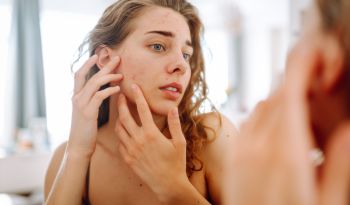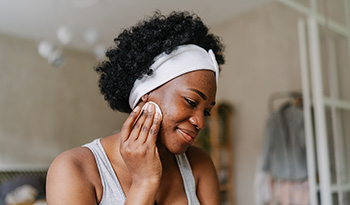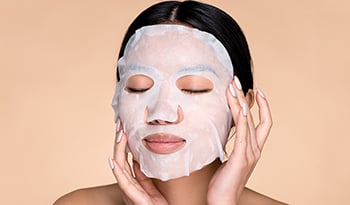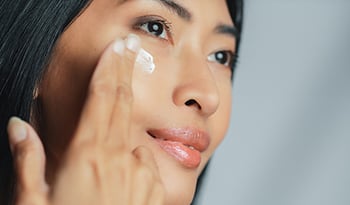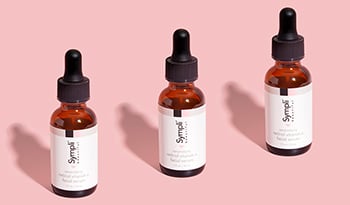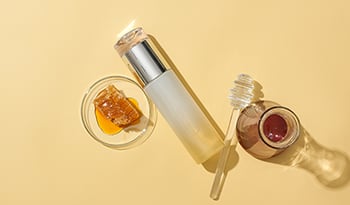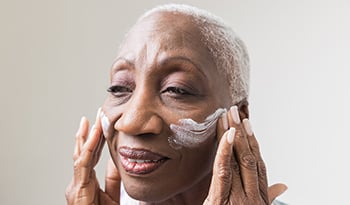How can be can be to be a meggszabadulni a zsíros bőrt

A zsíros bőr sok tizenéves és felnőtt számára egyaránt aggodalomra ad okot. Mivel a zsíros bőrnek sok eredete van, annak okának kitalálása kihívást jelenthet, ami különösen irritálóvá teszi ezt a bőrbetegséget. És bár az egyszerű életmódváltozások és bizonyos bőrápolási termékek javíthatják vagy akár megoldhatják a zsíros bőr egyes okait, más okokat nehezebb kijavítani. Szerencsére számos módja van a zsíros bőr javítására, függetlenül az eredettől.
Mi okozza a zsíros bőrt?
A zsíros bőrt számos tényező okozhatja - egyesek a mi irányításunk alatt állnak, mások pedig nem. Míg a zsíros bőrre gyakorolt genetikai hajlam nagyobb kihívást jelenthet a leküzdés, jogorvoslatok állnak rendelkezésre. A hormonális változások és az életmódbeli tényezők mind befolyásolhatják az olajtermelést. Például a hozzáadott cukorban, rossz minőségű zsírokban és erősen feldolgozott élelmiszerekben gazdag étrend csökkentheti a bőr integritását, ami nagyobb olajtermeléshez vezethet.
Végül a bőrön használt termékek és a napi bőrápolási rutin szintén befolyásolhatják az olajtermelést. Egyes termékek eltávolítják a természetes olajokat a bőrről, jelezve a szervezetnek, hogy több olajat termeljen.
A zsíros bőr kezelése legfontosabb kérdés a bőrgyógyászok számára, akik segíthetnek azonosítani a zsíros bőr okait, és segíthetnek olyan bőrápolási rutin kialakításában, amely megfelel az egyéni bőr igényeinek.
Természetes gyógymódok zsíros bőrre
Bár bőrgyógyásza javasolhat vagy írhat elő vény nélkül kapható vagy vényköteles kezeléseket, számos természetes gyógymód áll rendelkezésre a zsíros bőrre, amelyet felfedezhet. Míg néhányat, mint például az agyagmaszkok és a foltópapírok, elsődleges funkcióiként javítják a zsíros bőrt, sok háztartási összetevő javíthatja zsíros bőrét. És bár egyesek ideiglenesen csökkenthetik az olaj megjelenését a bőrön, mások proaktívabban dolgoznak a folyamatos olajtermelés csökkentése érdekében.
Folyópapírok
A foltos papírok gyorsan és egyszerűen csökkenthetik a bőrön lévő olajat - azonban általában ideiglenes megoldást jelentenek. Ha kint tartózkodik, és egyszerű módszerre van szüksége a bőrön lévő olaj kezelésére, a törlőpapír az egyik legkényelmesebb megoldás.
Ha finoman megpattanják a bőrt, a foltos papírok felszívják az olajat, eltávolítva azt a bőr felületéről. Ez csökkenti a sokak nem kedvelő fényes megjelenését, és mattebb megjelenést eredményez. Olvassa el a zsíros bőrre vonatkozó további megoldásokat, amelyek összességében csökkenthetik az olajtermelést.
Méz
A méz háztartási összetevő, amely javíthatja a zsíros bőrt. Bár már használhatja a tea édesítésére, sütéshez és főzéshez, a méz egyedülálló tulajdonságokkal rendelkezik, amelyek helyileg alkalmazva előnyösek a bőrének.
A méz természetes antibakteriális és antiszeptikus tulajdonságokkal rendelkezik, amelyek csökkenthetik a mikrobákat a bőrön és csökkenthetik az olajtermelést. Ezenkívül a méz antibakteriális tulajdonságai miatt csökkentheti a foltok és pattanások valószínűségét.
Bár a méz minden formája felhasználható arcmaszk készítéséhez, a manuka méz a méz egyedülálló formája, amely még több antimikrobiális tulajdonsággal rendelkezik, mint a hagyományos édesítőszer. Mézes maszkot készíthet úgy, hogy a mézet és a zabot keverjük össze egy turmixgépben, és felhordjuk az arcára. Óvatosan dörzsölje meg a keveréket az arcára, majd mossa le teljesen.
Kozmetikai agyag maszkok
A foltópapírokhoz hasonlóan az agyagmaszkok felszívják a felesleges olajat a bőr felületéről. Bár ez nem biztos, hogy gyors megoldás útközben, a rendszeres bőrápolási rutin részeként a maszkolása csökkentheti a bőr olajtermelését, miközben csökkenti az „olaj fényét”.
Sok kozmetikai márka készít használatra kész agyagmaszkokat , amelyeket közvetlenül a bőrére felhordhat, és egy ideig hagyhatja rajta, mielőtt egyszerűen lemosnák. Egyes agyagtermékek kombinálhatók más összetevőkkel, például almaecettel, arcmaszk létrehozásához. Nem számít, melyik agyagterméket használ, ügyeljen arra, hogy kövesse a csomagolás utasításait a biztonságos használat érdekében.
Aloe Vera
A mézhez hasonlóan az aloe vera egy másik háztartási termék, amely sok szempontból előnyös lehet a bőr számára. Bár előfordulhat, hogy otthon már van boltban vásárolt gél , amely enyhíti a napégési kellemetlenségeket, ezt a terméket az arcára is felviheti, hogy elriasztja a zsíros bőrt. A friss aloe vera hidratálóként is alkalmazható a bőrre, amely csökkenti az olajtermelést.
Bármilyen aloe használatakor fontos, hogy először teszteljen egy kis bőrfoltot, mielőtt nagyobb területen használná. Vannak, akik allergiásak az aloe-ra - a tapaszteszt segít elkerülni a szélesebb körben elterjedtebb kellemetlenségeket, ha érzékenysége van.
Zabliszt
Bár hozzászoktál ahhoz, hogy a zabpehelyt eszel ahelyett, hogy a bőrére felhordja, a házi zabpehely maszk egy másik megoldás a zsíros bőrre. A zabpehely természetes gyulladáscsökkentő tulajdonságokkal rendelkezik, így a bőrre alkalmazva csökkentheti a bőrpírot, valamint a pattanások és foltok megjelenését is. Ezenkívül a helyileg alkalmazott zabpehely felszívhatja az olajat, csökkentve a bőr felületén nyugvó mennyiséget.
Kombinálhatja a mézet és a zabpehelyet egy egyszerű maszk készítéséhez, vagy keverhet össze 2 evőkanál zabpehelyet 1 teáskanál szódabikarbónával és annyi vízzel a paszta létrehozásához. Vigye fel a bőrére kb. 10 percig, és alaposan öblítse le olajcsökkentő maszkhoz.
Jojoba olaj
Az olaj felvitele az arcára ellentmondásnak tűnhet, ha zsíros bőre van. Azonban a jojobaolaj olyan összetevő, amely előnyös lehet a zsíros vagy pattanásra hajlamos bőr számára.
Helyileg alkalmazva a jojobaolaj kiegyensúlyozhatja a természetes olajtermelést, csökkentve a bőr termelt olaj mennyiségét. A jojobaolajat szintén nem komedogénnek tekintik, ami azt jelenti, hogy nem fogja eltömíteni a pórákat - ez egy újabb előny, ha pattanásoktól szenved. A jojobaolaj közvetlenül az arcára történő alkalmazása hidratálja a bőrt, miközben enyhíti az olajtermelést. Az olajellenes erő növelése érdekében fontolja meg a jojobaolaj hozzáadását kedvenc agyagmaszkjához.
Tojásfehérje és citromlé
A tojásfehérje és a citromlé kombinációja egy másik házi maszk, amelyet az olajtermelés csökkentésére használnak. Az arcra alkalmazva a tojásfehérje bezárhatja a pórusokat és csökkentheti a faggyú (olaj) szekrécióját. Ez kevésbé zsíros archoz vezethet, és csökkentheti a pattanások és foltok valószínűségét.
A maszkban lévő citromlé könnyű fehérítőszerként szolgál, elősegítve az arcszín kiegyenlítését. A hígítatlan citromlevet nem szabad közvetlenül a bőrön használni, mivel reakciót és égő érzést okozhat. Ehelyett hígítsa fel a citromlevet, mielőtt hozzáadná a tojásfehérjéhez a maszk elkészítésekor. Miután a maszk kb. 10 percig állt, alaposan mossa le meleg vízzel.
Mandula
Természetesen a mandula finom és tápláló snacket készít, de javíthatja a zsíros bőrt is. A mandula egészséges telítetlen zsírok forrása. Konyhai robotgépben összetörve és a bőrre felhordva kiegyensúlyozhatják a bőrolaj termelését is. A mandulában található E -vitamin saját előnyeit is nyújtja, például fényesíti a bőrt és javítja az UV-expozíció okozta bőrkárosodást.
Használjon egyenlő mennyiségű mézet és zúzott mandulát, majd vigye fel ezt a hámlasztó radírt az arcára. Finoman masszírozza be a bőrbe, majd öblítse le.
Mossa meg az arcát
A zsíros bőr javításának egyik legnyilvánvalóbb módja az arc mosása a felesleges olaj eltávolítása érdekében. Bár ez egyszerűnek hangzik, néhány dolgot szem előtt kell tartani annak biztosítása érdekében, hogy segítsen - és ne fájjon - a bőr állapotának.
Először azonosítsa a bőr típusát, hogy meghatározza a megfelelő tisztítószer típusát a bőrének. A zsíros bőrűek számára előnyös lehet az olajmentes tisztítószer, például habzó vagy gél tisztító. Számos más összetevő is előnyös lehet a zsíros bőr számára. Tekintse meg ezt a cikket, ahol a bőrgyógyász véleménye arról, hogy mely összetevőket kell keresni a tisztítószer kiválasztásakor.
Végül kérdezze meg bőrgyógyászát, hogy milyen gyakran kell mosni az arcát. A tisztítószerrel való túl gyakori mosás - vagy nem elég gyakran - befolyásolhatja a faggyútermelést. A legtöbb esetben nem szabad naponta kétszer mosni az arcát, és néhánynak előnyös lehet, ha a tisztítást napi egyszerre korlátozzák.
Napi tippek zsíros bőrre
A zsíros bőr kezelése próbát és hibát igényelhet. Ami a barátodnak működik, lehet, hogy nem működik neked - és fordítva. Ezekkel a tippekkel, trükkökkel és tanácsokkal azonban jó úton lesz a gyönyörű, egészséges bőr felé.
Bár izgatottan kipróbálhatja ezeket az új bőrápolási ötleteket zsíros bőrre, ne valósítsa meg őket egyszerre. Hagyjon néhány napot az új termékek vagy házi maszkok kipróbálása között, hogy elkerülje az arc érzékeny bőrének túlterhelését. Ha túl sok új kezeléssel túlzásba kerül, még több arcszínproblémához vezethet.
A zsíros bőr új kezeléseinek kipróbálása mellett győződjön meg róla, hogy jól hidratált marad. A kiszáradás súlyosbíthatja a zsíros bőrt, ezért igyon sok vizet egész nap, és törekedjen naponta legalább 80 uncia teljes folyadékra. Egy újrafelhasználható palack kéznél tartása nagyszerű módja annak, hogy naprakész maradjon folyadékszükségleteivel.
Ezenkívül keressen olajmentes bőrápoló- és sminktermékeket a zsíros bőr javítása érdekében. És ne felejtse el hidratálni a bőrt. Bár úgy tűnhet, hogy a hidratáló még olajosabbá teheti a bőrt, a hidratálás elengedhetetlen a bőr nedvességtartalmának szabályozásához, az olajosság javításához és az egészséges bőr eléréséhez.
Referenciák:
- Michalak M. Növényi kivonatok bőrápoló és terápiás szerekként. Int J Mol Tudomány 2023; 24 (20): 15444. Közzétéve 2023. október 22-én.
- Capone K, Kirchner F, Klein SL, Tierney NK. A kolloid zabpehely helyi atópiás dermatitis krém hatása a bőr mikrobiómájára és a bőrgát tulajdonságaira. J Gyógyszerek Dermatol. 2020; 19 (5): 524-531.
- Lin TK, Zhong L, Santiago JL. Egyes növényi olajok helyi alkalmazásának gyulladáscsökkentő és bőrgátló javító hatásai. Int J Mol Tudomány 2017; 19 (1) :70. Közzétéve: 2017. december 27.
- Kurek-Górecka A, Górecki M, Rzepecka-Stojko A, Balwierz R, Stojko J. Méhészeti termékek a bőrgyógyászatban és a bőrápolásban. Molekulák. 2020; 25 (3) :556.
FELELŐSSÉGKIZÁRÓ NYILATKOZAT:A jelen blognak nem célja diagnózis felállítása...








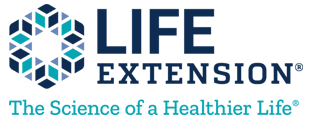








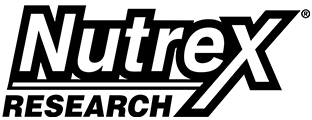





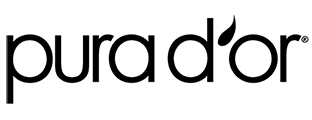









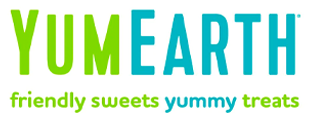



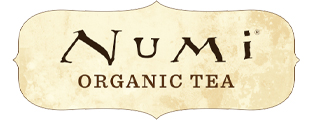


















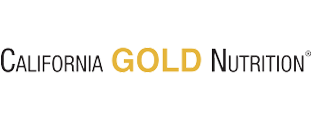
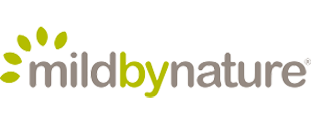

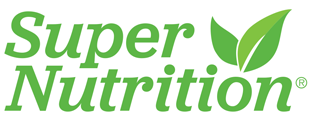





















 Tartalomjegyzék
Tartalomjegyzék



